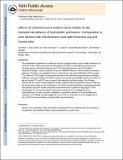Effects of ultrasound and sodium lauryl sulfate on the transdermal delivery of hydrophilic permeants: Comparative in vitro studies with full-thickness and split-thickness pig and human skin
Author(s)
Seto, Jennifer E.; Polat, Baris E.; Blankschtein, Daniel; Langer, Robert; Lopez, Renata F. V.
DownloadBlankschtein_Effects of ultrasound.pdf (432.2Kb)
PUBLISHER_CC
Publisher with Creative Commons License
Creative Commons Attribution
Terms of use
Metadata
Show full item recordAbstract
The simultaneous application of ultrasound and the surfactant sodium lauryl sulfate (referred to as US/SLS) to skin enhances transdermal drug delivery (TDD) in a synergistic mechanical and chemical manner. Since full-thickness skin (FTS) and split-thickness skin (STS) differ in mechanical strength, US/SLS treatment may have different effects on their transdermal transport pathways. Therefore, we evaluated STS as an alternative to the well-established US/SLS-treated FTS model for TDD studies of hydrophilic permeants. We utilized the aqueous porous pathway model to compare the effects of US/SLS treatment on the skin permeability and the pore radius of pig and human FTS and STS over a range of skin electrical resistivity values. Our findings indicate that the US/SLS-treated pig skin models exhibit similar permeabilities and pore radii, but the human skin models do not. Furthermore, the US/SLS-enhanced delivery of gold nanoparticles and quantum dots (two model hydrophilic macromolecules) is greater through pig STS than through pig FTS, due to the presence of less dermis that acts as an artificial barrier to macromolecules. In spite of greater variability in correlations between STS permeability and resistivity, our findings strongly suggest the use of 700 μm-thick pig STS to investigate the in vitro US/SLS-enhanced delivery of hydrophilic macromolecules.
Date issued
2010-03Department
Massachusetts Institute of Technology. Department of Chemical EngineeringJournal
Journal of Controlled Release
Publisher
Elsevier
Citation
Seto, Jennifer E., Baris E. Polat, Renata F.V. Lopez, Daniel Blankschtein, and Robert Langer. “Effects of Ultrasound and Sodium Lauryl Sulfate on the Transdermal Delivery of Hydrophilic Permeants: Comparative in Vitro Studies with Full-Thickness and Split-Thickness Pig and Human Skin.” Journal of Controlled Release 145, no. 1 (July 1, 2010): 26–32.
Version: Author's final manuscript
ISSN
01683659